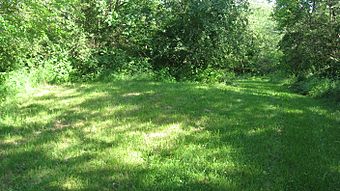Carl Potter Mound facts for kids
Quick facts for kids |
|
|
Carl Potter Mound
|
|

Overview of the mound
|
|
| Location | East of State Route 56 in Union Township |
|---|---|
| Nearest city | Mechanicsburg, Ohio |
| Area | 1 acre (0.40 ha) |
| NRHP reference No. | 74001407 |
| Added to NRHP | August 13, 1974 |
The Carl Potter Mound is an old Native American earth mound in Ohio. It's also called "Hodge Mound II." This special mound is found in a field near Mechanicsburg, Ohio. It sits on a small hill in Union Township. In 1974, the mound was added to the National Register of Historic Places. This means it's an important historical site. It was listed because it was likely used as a burial place long ago.
Ancient Earthworks in Ohio
Long ago, the valleys of the Scioto and Miami rivers in Ohio had many ancient earthworks. These were built by early Native American groups. Champaign County is located between these two rivers. Because of this, it has fewer earthworks than other counties.
A study from 1914 found only six mounds in Champaign County. It also noted eighteen other ancient sites. This is much less than nearby Logan County, which had thirty-three mounds. Miami County to the west had twenty-two mounds. The Carl Potter Mound was not known during that 1914 study. However, it is one of several mounds found on a single farm in Union Township.
Discoveries Near the Mound
In the late 1800s, people dug into a gravel hill on the same farm. This hill, called a kame, was in the barnyard. They found several burials and old tools. These items are thought to be from the Cole period of Native American history.
Another smaller mound, called "Hodge Mound I," is also on the Potter farm. Farmers have plowed over this mound many times. Now, it's almost flat with the ground. You can only see where it was when the field is plowed. Then, you might spot bits of charcoal in the soil. The Carl Potter Mound is different. It is not plowed anymore. While it used to be plowed, it is now protected.
In the 1930s, some boys dug into the Carl Potter Mound. They found some bones and a stone axe with grooves. No other digging has happened since then. Experts believe the mound still holds more burials and artifacts. The grooved axe alone doesn't tell us who built the mound. Similar axes have been found at sites from the early Adena culture and even older groups.
However, experts think the Adena people built the Carl Potter Mound. Many confirmed Adena sites are on small hills near streams. The Carl Potter Mound fits this pattern. If the Adena built it, they were likely a group living away from the main Adena areas. Those main areas were in the Scioto River valley to the east.
Protecting the Mound
In 1970, an archaeologist named Stephen C. Koleszar studied ancient sites in southwest Ohio. In 1914, six mounds were known in Champaign County. But by 1970, only three mounds were left. The Carl Potter Mound was one of these three.
Four years later, in 1974, the Carl Potter Mound was added to the National Register of Historic Places. This was done to help protect it. It was named the "Carl Potter Mound" after its owner, Carl Potter. Its older name, "Hodge Mound," came from a past owner, James A. Hodge.



